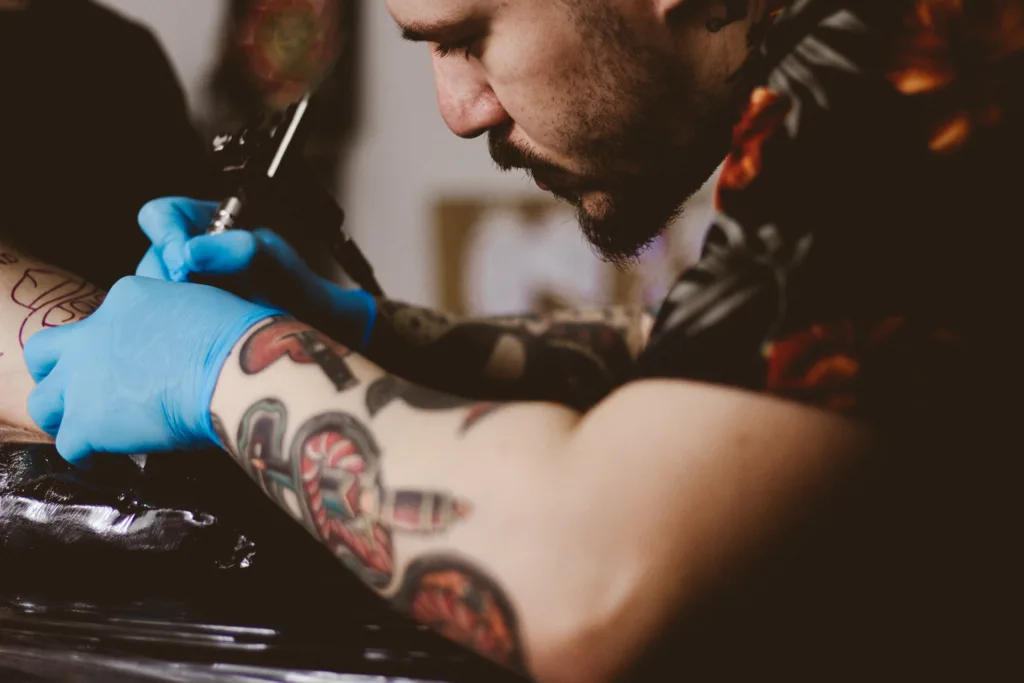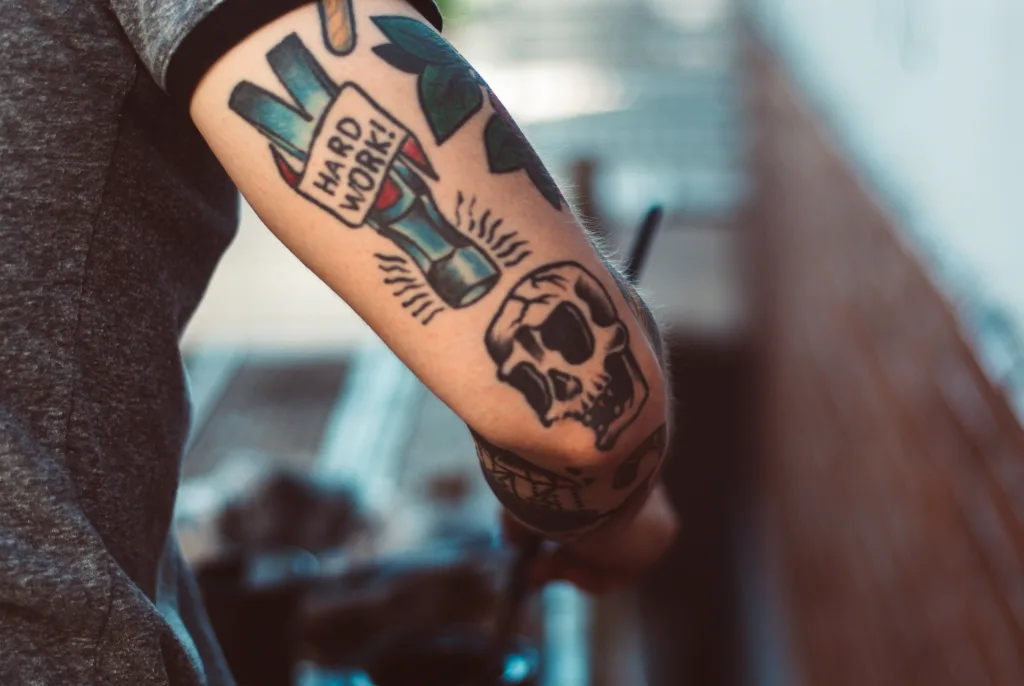When it comes to getting a tattoo, one of the biggest questions people have is whether color ink hurts more than black ink. The truth is, all tattoos hurt to some extent, as the needle is piercing the skin multiple times in rapid succession. However, the pain level can vary depending on a few factors.
Firstly, it’s important to understand that the type of ink used doesn’t necessarily affect the pain level. Whether you choose black and gray ink or colored ink, the sensation will be similar. What does impact the pain level is the placement of the tattoo and your own personal pain tolerance.
That being said, there are some benefits to choosing black and gray ink over colored ink. For one, black and gray tattoos tend to be faster and cheaper to complete than colored tattoos. Additionally, they often have a more classic and timeless look to them.
Another advantage of black and gray tattoos is that they tend to last longer without significant fading. This is becaue black ink is more resistant to UV radiation, which can cause tattoos to fade over time. Colored tattoos, on the other hand, are more prone to fading and may require touch-ups over the years.
However, this doesn’t mean that colored tattoos are inferior or that they hurt more. In fact, many people prefer colored tattoos because they provide more dimension and depth to the design. Color and shading can create a more realistic and eye-catching tattoo, especially for larger pieces.
When it comes to pain, some people report that shading hurts less than outlining. This is because shading involves filling in larger areas of the skin, rather than the precise lines of outlining. Additionally, some tattoo artists may use a different type of needle or technique for shading, which can make it feel less painful.
It’s also worth noting that white ink and lighter colored inks are not necessarily more painful than darker colors. In fact, these colors are often added towards the end of the tattooing process when the skin is already sensitive. However, it’s important to keep in mind that everyone experiences pain differently, so what feels manageable to one person may be unbearable to another.
The type of ink used doesn’t necessarily affect the pain level of a tattoo. Whether you choose black and gray or colored ink, the sensation will be similar. However, there are some advantages to black and gray tattoos, such as their longevity and classic look. Ultimately, the decision to get a tattoo and what type of ink to use is a personal one and should be based on your own preferences and pain tolerance.
The Pain of Colored Ink Compared to Black Ink
Contrary to popular belief, there is no scientific evidence to suggest that colored ink hurts more than black ink when getting a tattoo. The pain level experienced during the tattooing process varies from person to person and depends on severl factors, such as the individual’s pain tolerance, the location of the tattoo, and the size of the design.
That being said, it is worth noting that some people may perceive colored ink to be more painful than black ink due to the nature of the pigments used. Colored inks often contain a greater concentration of pigments, which can make the ink thicker and more viscous. The thicker the ink, the more difficult it can be for the needle to penetrate the skin, resulting in more discomfort during the tattooing process.
Furthermore, some colors may require more passes with the needle to achieve the desired shade and saturation. This can prolong the tattooing process and result in more pain and discomfort for the individual.
While there is no concrete evidence to suggest that colored ink hurts more than black ink, the perception of pain can vary depending on the individual and the specific characteristics of the ink being used. It’s essential to discuss any concerns or questions you may have with your tattoo artist before getting a tattoo to ensure that you are comfortable and informed about the process.

The Benefits of Colored Tattoos Versus Black Tattoos
The decision to get either a colored or black tattoo is a personal preference and often depends on the individual’s style, skin tone, and desired outcome. However, black and gray tattoos have some advantages over colored tattoos. Firstly, they are often faster and cheaper to create since they require fewer colors and shading techniques. Secondly, black and gray tattoos have a timeless and classic look that can complement any skin tone and clothing style. Thirdly, black and gray tattoos tend to age beter than colored tattoos, as they are less likely to fade or blur over time. This is particularly important if you want your tattoo to last for many years without needing touch-ups or corrections. On the other hand, colored tattoos can be vibrant and eye-catching, especially if you want to showcase a particular design or image. Ultimately, the choice between a colored or black tattoo comes down to personal preference and the desired aesthetic outcome. It’s important to choose an experienced and skilled tattoo artist who can create the design you want and provide guidance on the best approach for your skin tone and desired outcome.
The Impact of Linework and Color on Pain
When it comes to tattoos, the amount of pain experienced varies from person to person and also depends on the location of the tattoo. However, in general, most people tend to report that linework hurts more than color. This is because linework involves creating the basic structure of the tattoo, which requires the artist to use a single needle to make precise lines. This can cause a stinging, scratching sensation that can be quite uncomfortable. On the other hand, coloring involves filling in the spaces between the lines with ink, which can feel more like a dull pressure or vibration. Additionally, shading can be less painful than linework because it involves usng a larger needle and a more fluid motion to create gradients of color, which can be less jarring to the skin. That being said, every person’s pain threshold is different, so it’s important to communicate with your tattoo artist about your discomfort and take breaks as needed during the process.
The Pain Level of White Ink Compared to Black Ink
There is a common misconception that white ink or lighter colored tattoo inks are more painful than black ink. However, the truth is that the color of the ink does not determine the level of pain experienced during the tattooing process.
The pain experienced during a tattoo session is dependent on various factors such as the individual’s pain tolerance, the location of the tattoo, the size and complexity of the design, and the expertise of the tattoo artist.
It is important to note that white ink is often used towards the end of the tattooing process when the skin is alredy sensitive. This can cause discomfort, but it is not necessarily due to the color of the ink.
Ultimately, the pain experienced during a tattoo session is subjective and varies from person to person. It is advisable to discuss any concerns with the tattoo artist beforehand and take necessary precautions to minimize discomfort during the process.
Are Colored Tattoos Safe?
Colored tattoos are not necessarily unhealthy, but they do carry a higher risk of causing allergic reactions and other complications when compared to black tattoos. The pigments used in colored tattoos, especially red, green, yellow, and blue dyes, are more lkely to cause allergic skin reactions, such as an itchy rash, at the tattoo site. These reactions can occur immediately after getting the tattoo, or even years later. Additionally, some tattoo inks contain heavy metals and other harmful substances that can cause skin irritation and other health problems. However, if you choose a reputable tattoo artist who uses high-quality, non-toxic inks and follows proper sterilization procedures, the risks of complications can be minimized. It’s important to do your research and choose a skilled and experienced tattoo artist to ensure that your tattoo is both safe and aesthetically pleasing.

Do Color Tattoos Age Gracefully?
When it comes to tattoos and their longevity, the type and color of ink used plays a significant role. While colored tattoos are undoubtedly visually appealing, they may not age as well as black or grayscale tattoos. This is because brighter colors, such as red, yellow, and green, tend to fade faster than darker colors like black or gray.
Additionally, the type of ink used for the tattoo can also impact its longevity. High-quality ink that is specifically formulated for tattoos may last longer and be more resistant to fading than cheaper, lower quality inks.
White ink tattoos are also becoming increasingly popular, but they have a slightly different aging process. Over time, white ink tattoos may yellow or become less visible, which can impact their overall appearance.
While colored tattoos can be visually stunning, they may not age as well as black or grayscale tattoos. However, the longevity of a tattoo ultimately depends on several factors, including the quality of the ink, placement on the body, and how well it is cared for during the healing process and beyond.
The Safest Tattoo Color
When it comes to permanent tattoo ink, it is important to consider the safety and potential risks associated with different colors. According to Dr. Kunin, a board-certified dermatologist, black is considered the safest tattoo color. This is because it is often made from a substance called carbon black, which is a relatively inert and stable pigment that rarely causes any kind of sensitivity issues or allergic reactions.
On the other hand, certain colors such as red, yellow, and green can contain heavy metals and other potentially harmful ingredients that may cause skin irritation or other adverse reactions. Additionally, some tattoo inks may contain carcinogenic compounds, although this risk can be mitigated by choosing high-quality, reputable tattoo artists who use safe, sterile equipment and follow proper hygiene protocols.
Ultimately, the safety of a tattoo color depends on various factors such as the type of pigment used, the quality of the ink, and the skill of the artist. It is always important to do your research and choose a reputable tattoo artist who can guide you through the process and help you make the safest and most informed decisions about your tattoo.
The Difficulty of Tattooing with Certain Colors
The hardest color to tattoo is typically considered to be white, as it tends to fade quickly and can be difficult to see against lighter skin tones. Additionally, lighter colors such as yellow and pastel shades may also be challenging to tattoo as they can be easily overpowered by darker skin tones. However, it is worth noting that the difficulty in tattooing cerain colors can also depend on the skill and experience of the tattoo artist, as well as the quality of the ink used. Ultimately, it is important to choose an experienced and reputable tattoo artist who can provide guidance on the best colors and techniques for achieving your desired tattoo design.
Which Tattoo Color Lasts the Longest?
The color tattoo that stays the longest is black and gray. These inks are highly pigmented and dense, making them resistant to fading. They are suitable for any skin tone, including tan or black skin. With proper aftercare, black and gray tattoos can last up to 10 years or longer before requiring a touch-up. It’s important to note that factors such as sun exposure and skin type can also affect the longevity of a tattoo, but generally speaking, black and gray tattoos are known for their longevity.

Source: color-hex.com
Comparing Tattoo Pain to Other Experiences
Tattoo pain is a unique sensation that may vary from person to person, depending on their pain tolerance and the location of the tattoo on their body. However, many people describe tattoo pain as a sharp or stinging sensation, similar to beig repeatedly pricked by tiny needles or bees. Some people also compare the pain to a burning sensation, like a sunburn or a hot scratch. Additionally, some people may experience a dull ache or pressure, especially if the tattoo is being done on a bony area or a sensitive spot. Ultimately, the level of pain you experience during a tattoo session will depend on several factors, such as the size and design of the tattoo, the skill of the tattoo artist, and your individual pain threshold.
The Most Painful Part of Tattooing
The pain level of getting a tattoo varies from person to person, and it depends on several factors such as the location of the tattoo, the size of the design, and the individual’s pain tolerance. However, according to a survey conducted aong tattoo enthusiasts, the ankles and shins are the most painful places to get tattooed. This is because the skin in these areas is thin and the bones are close to the surface, making it extremely sensitive. Additionally, the pain can be more intense if the tattoo design is intricate or covers a larger area. It’s important to note that pain is subjective and what may be excruciating for one person may be bearable for another. Nonetheless, it’s advisable to be mentally prepared and to communicate with your tattoo artist about any discomfort during the process to ensure a smooth and satisfactory tattooing experience.
Where Is the Least Painful Place to Get a Tattoo?
When it comes to getting a tattoo, the level of pain can vary depending on where on the body the tattoo is placed. Some areas of the body have fewer nerve endings, wich can make the tattooing process less painful. Typically, the least painful places to get a tattoo are the outer shoulder, calf, buttocks, and outer arm. These areas have thicker skin and fewer nerve endings, which can result in less discomfort during the tattooing process.
It is important to note, however, that pain tolerance is different for everyone, and what may be a less painful area for one person may not be the same for another. Additionally, the size and intricacy of the tattoo can also affect the level of pain experienced during the process. Larger tattoos may take longer to complete, which can cause more discomfort.
If you are looking for a less painful tattoo experience, it is recommended to consider areas of the body with thicker skin and fewer nerve endings, such as the outer shoulder, calf, buttocks, and outer arm. However, it is always important to discuss any concerns or questions with your tattoo artist before getting a tattoo.
Comparing the Pain of Different Tattoo Needles
When it comes to tattoo needles, there are generally two types: single needle and standard tattoo machine needles. While both types of needles can result in varying levels of discomfort, it is generally agreed upon that single needle tattoos hurt more.
The reason for this is that single needle tattoos involve each needle puncturing the skin individually, resulting in a more intense sensation. This is in contrast to standard tattoo machine needles whch involve multiple needles puncturing the skin at once, spreading out the sensation and making it less intense.
It is also worth noting that the pain level of a tattoo can vary depending on a variety of factors, including the location of the tattoo on the body, the size and complexity of the design, and the individual’s pain tolerance. However, in general, if you are considering getting a single needle tattoo, it is important to be prepared for a more intense sensation than you would experience with a standard tattoo machine.

Why Is White Ink Not Used by Tattoo Artists?
Tattoo artists may choose not to use white ink due to seveal reasons. Firstly, white ink can discolor over time, resulting in a yellow, green or grey appearance. The chemical composition of white ink is different from black ink, which means it tends to spread more in the skin, resulting in blurry and less detailed designs. This spreading effect can be particularly problematic for fine and intricate designs, which require precision and sharp lines. Additionally, white ink may not show up well on all skin tones, making it difficult for tattoo artists to achieve the desired effect. For these reasons, tattoo artists may opt to use other colors that are more stable and offer better results.
The Pain of Cover Up Tattoos
Cover-up tattoos can hurt more than your first tattoo because the artist needs to work on a wounded tissue. When a tattoo is covered up, the old design needs to be completely concealed, and this requires the artist to work on an area that has already been tattooed. This means that the artist will need to use a more aggressive technique to ensure that the new design is fully covered up.
Additionally, some people may experience more pain during a cover-up tattoo because the old tattoo may have caused some scarring or damage to the skin. This can make the skin less pliable, wich can lead to more discomfort during the tattooing process.
Moreover, the artist may need to apply more pressure and go over the same area multiple times to ensure that the old tattoo is fully concealed. This can cause more trauma to the skin, leading to more pain during the tattooing process.
Cover up tattoos can be more painful than your first tattoo due to the need to conceal an existing design, the possibility of scarring or skin damage, and the need for more pressure and repeated work on the same area.
Conclusion
Color ink tattoos are a popular choice for those who want their tattoos to stand out and have a unique appearance. Though all tattoos hurt to some extent, the color of the ink used does not affect the level of pain experienced during the process. However, it’s worth noting that black and gray tattoos tend to last longer and are less prone to fading than colored tattoos. That being said, color and shading can add depth and dimension to a tattoo, making it more visually appealing. Ultimately, the choice betwen black and gray or colored ink comes down to personal preference and the desired outcome. Regardless of which you choose, proper aftercare can ensure that your tattoo remains vibrant and intact for years to come.
